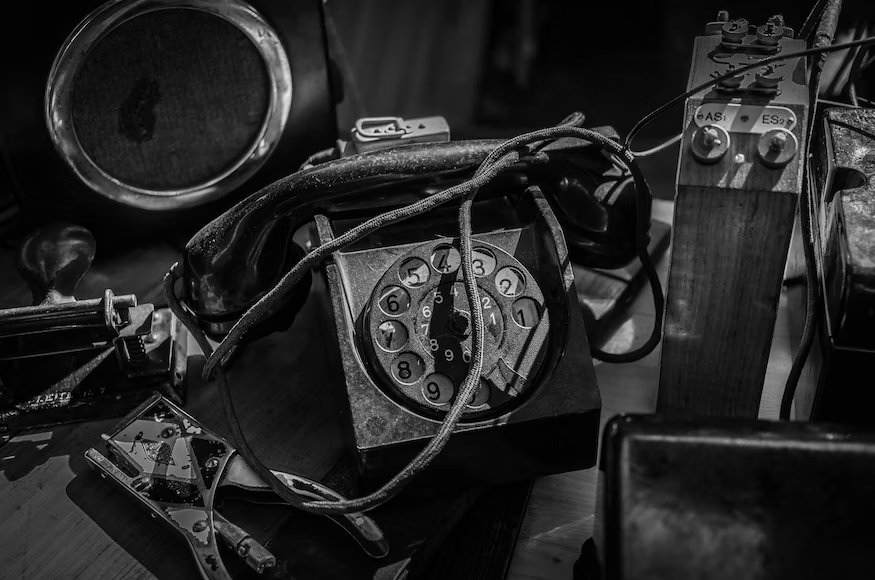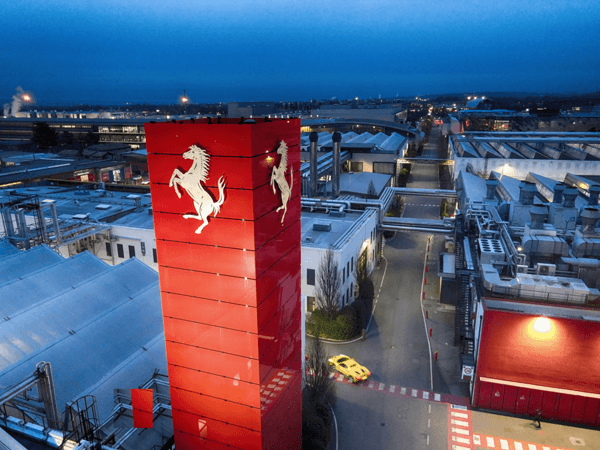The history of computers began with primitive designs in the early 19th century and went on to change the world during the 20th century.
कंपà¥à¤¯à¥‚टर का इतिहास 19वीं शताबà¥à¤¦à¥€ की शà¥à¤°à¥à¤†à¤¤ में आदिम डिजाइनों के साथ शà¥à¤°à¥‚ हà¥à¤† और 20वीं शताबà¥à¤¦à¥€ के दौरान दà¥à¤¨à¤¿à¤¯à¤¾ को बदलने के लिठचला गया।
The history of computers goes back over 200 years. At first theorized by mathematicians and entrepreneurs, during the 19th century mechanical calculating machines were designed and built to solve the increasingly complex number-crunching challenges. The advancement of technology enabled ever more-complex computers by the early 20th century, and computers became larger and more powerful.
कंपà¥à¤¯à¥‚टर का इतिहास 200 साल से अधिक पà¥à¤°à¤¾à¤¨à¤¾ है। पहली बार गणितजà¥à¤žà¥‹à¤‚ और उदà¥à¤¯à¤®à¤¿à¤¯à¥‹à¤‚ दà¥à¤µà¤¾à¤°à¤¾ सिदà¥à¤§à¤¾à¤‚तित, 19 वीं शताबà¥à¤¦à¥€ के दौरान यांतà¥à¤°à¤¿à¤• गणना मशीनों को तेजी से जटिल संखà¥à¤¯à¤¾-कà¥à¤°à¤‚चिंग चà¥à¤¨à¥Œà¤¤à¤¿à¤¯à¥‹à¤‚ को हल करने के लिठडिज़ाइन और निरà¥à¤®à¤¿à¤¤ किया गया था। पà¥à¤°à¥Œà¤¦à¥à¤¯à¥‹à¤—िकी की पà¥à¤°à¤—ति ने 20वीं शताबà¥à¤¦à¥€ की शà¥à¤°à¥à¤†à¤¤ तक और अधिक जटिल कंपà¥à¤¯à¥‚टरों को सकà¥à¤·à¤® किया, और कंपà¥à¤¯à¥‚टर बड़े और अधिक शकà¥à¤¤à¤¿à¤¶à¤¾à¤²à¥€ हो गà¤à¥¤
Today, computers are almost unrecognizable from designs of the 19th century, such as Charles Babbage's Analytical Engine — or even from the huge computers of the 20th century that occupied whole rooms, such as the Electronic Numerical Integrator and Calculator.
आज, कंपà¥à¤¯à¥‚टर 19वीं सदी के डिजाइनों से लगà¤à¤— पहचाने नहीं जा सकते, जैसे चारà¥à¤²à¥à¤¸ बैबेज का à¤à¤¨à¤¾à¤²à¤¿à¤Ÿà¤¿à¤•à¤² इंजन - या यहां तक कि 20वीं सदी के विशाल कंपà¥à¤¯à¥‚टरों से à¤à¥€, जो पूरे कमरों पर कबà¥à¤œà¤¾ कर लेते थे, जैसे कि इलेकà¥à¤Ÿà¥à¤°à¥‰à¤¨à¤¿à¤• नà¥à¤¯à¥‚मेरिकल इंटीगà¥à¤°à¥‡à¤Ÿà¤° और कैलकà¥à¤²à¥‡à¤Ÿà¤°à¥¤
Here's a brief history of computers, from their primitive number-crunching origins to the powerful modern-day machines that surf the Internet, run games and stream multimedia.
यहां कंपà¥à¤¯à¥‚टरों का à¤à¤• संकà¥à¤·à¤¿à¤ªà¥à¤¤ इतिहास दिया गया है, उनके आदिम नंबर-कà¥à¤°à¤‚चिंग मूल से लेकर शकà¥à¤¤à¤¿à¤¶à¤¾à¤²à¥€ आधà¥à¤¨à¤¿à¤•-दिन की मशीनें जो इंटरनेट पर सरà¥à¤« करती हैं, गेम चलाती हैं और मलà¥à¤Ÿà¥€à¤®à¥€à¤¡à¤¿à¤¯à¤¾ सà¥à¤Ÿà¥à¤°à¥€à¤® करती हैं।
1801: Joseph Marie Jacquard, a French merchant and inventor invents a loom that uses punched wooden cards to automatically weave fabric designs. Early computers would use similar punch cards.
1821: English mathematician Charles Babbage conceives of a steam-driven calculating machine that would be able to compute tables of numbers. Funded by the British government, the project, called the "Difference Engine" fails due to the lack of technology at the time, according to the University of Minnesota
1848: Ada Lovelace, an English mathematician and the daughter of poet Lord Byron, writes the world's first computer program. According to Anna Siffert, a professor of theoretical mathematics at the University of Münster in Germany, Lovelace writes the first program while translating a paper on Babbage's Analytical Engine from French into English. "She also provides her own comments on the text. Her annotations, simply called "notes," turn out to be three times as long as the actual transcript," Siffert wrote in an article for The Max Planck Society(opens in new tab). "Lovelace also adds a step-by-step description for computation of Bernoulli numbers with Babbage's machine — basically an algorithm — which, in effect, makes her the world's first computer programmer." Bernoulli numbers are a sequence of rational numbers often used in computation.
1853: Swedish inventor Per Georg Scheutz and his son Edvard design the world's first printing calculator. The machine is significant for being the first to "compute tabular differences and print the results," according to Uta C. Merzbach's book, "Georg Scheutz and the First Printing Calculator(opens in new tab)" (Smithsonian Institution Press, 1977).
1890: Herman Hollerith designs a punch-card system to help calculate the 1890 U.S. Census. The machine, saves the government several years of calculations, and the U.S. taxpayer approximately $5 million, according to Columbia University(opens in new tab) Hollerith later establishes a company that will eventually become International Business Machines Corporation (IBM).
1801: à¤à¤• फà¥à¤°à¤¾à¤‚सीसी वà¥à¤¯à¤¾à¤ªà¤¾à¤°à¥€ और आविषà¥à¤•à¤¾à¤°à¤• जोसेफ मैरी जैकà¥à¤µà¤¾à¤°à¥à¤¡ ने à¤à¤• करघे का आविषà¥à¤•à¤¾à¤° किया जो कपड़े के डिजाइन को सà¥à¤µà¤šà¤¾à¤²à¤¿à¤¤ रूप से बà¥à¤¨à¤¨à¥‡ के लिठछिदà¥à¤°à¤¿à¤¤ लकड़ी के कारà¥à¤¡ का उपयोग करता है। शà¥à¤°à¥à¤†à¤¤à¥€ कंपà¥à¤¯à¥‚टर इसी तरह के पंच कारà¥à¤¡ का इसà¥à¤¤à¥‡à¤®à¤¾à¤² करते थे।
1821: अंगà¥à¤°à¥‡à¤œà¥€ गणितजà¥à¤ž चारà¥à¤²à¥à¤¸ बैबेज ने à¤à¤• à¤à¤¾à¤ª से चलने वाली गणना मशीन की कलà¥à¤ªà¤¨à¤¾ की जो संखà¥à¤¯à¤¾à¤“ं की सारणी की गणना करने में सकà¥à¤·à¤® होगी। मिनेसोटा विशà¥à¤µà¤µà¤¿à¤¦à¥à¤¯à¤¾à¤²à¤¯ के अनà¥à¤¸à¤¾à¤°, बà¥à¤°à¤¿à¤Ÿà¤¿à¤¶ सरकार दà¥à¤µà¤¾à¤°à¤¾ वितà¥à¤¤ पोषित, "अंतर इंजन" नामक परियोजना उस समय पà¥à¤°à¥Œà¤¦à¥à¤¯à¥‹à¤—िकी की कमी के कारण विफल हो जाती है
1848: à¤à¤¡à¤¾ लवलेस, à¤à¤• अंगà¥à¤°à¥‡à¤œà¥€ गणितजà¥à¤ž और कवि लॉरà¥à¤¡ बायरन की बेटी, दà¥à¤¨à¤¿à¤¯à¤¾ का पहला कंपà¥à¤¯à¥‚टर पà¥à¤°à¥‹à¤—à¥à¤°à¤¾à¤® लिखती हैं। जरà¥à¤®à¤¨à¥€ में यूनिवरà¥à¤¸à¤¿à¤Ÿà¥€ ऑफ मà¥à¤‚सà¥à¤Ÿà¤° में सैदà¥à¤§à¤¾à¤‚तिक गणित के पà¥à¤°à¥‹à¤«à¥‡à¤¸à¤° à¤à¤¨à¤¾ सिफरà¥à¤Ÿ के अनà¥à¤¸à¤¾à¤°, लवलेस बैबेज के विशà¥à¤²à¥‡à¤·à¤£à¤¾à¤¤à¥à¤®à¤• इंजन पर à¤à¤• पेपर का फà¥à¤°à¥‡à¤‚च से अंगà¥à¤°à¥‡à¤œà¥€ में अनà¥à¤µà¤¾à¤¦ करते हà¥à¤ पहला कारà¥à¤¯à¤•à¥à¤°à¤® लिखता है। सिफरà¥à¤Ÿ ने द मैकà¥à¤¸ पà¥à¤²à¥ˆà¤‚क सोसाइटी के लिठà¤à¤• लेख में लिखा, "वह पाठपर अपनी टिपà¥à¤ªà¤£à¥€ à¤à¥€ पà¥à¤°à¤¦à¤¾à¤¨ करती है। उसकी टिपà¥à¤ªà¤£à¤¿à¤¯à¤¾à¤‚, जिसे केवल "नोटà¥à¤¸" कहा जाता है, वासà¥à¤¤à¤µà¤¿à¤• पà¥à¤°à¤¤à¤¿à¤²à¥‡à¤– से तीन गà¥à¤¨à¤¾ लंबी होती है (नठटैब में खà¥à¤²à¤¤à¥€ है) . "लवलेस बैबेज की मशीन के साथ बरà¥à¤¨à¥Œà¤²à¥€ संखà¥à¤¯à¤¾à¤“ं की गणना के लिठचरण-दर-चरण विवरण à¤à¥€ जोड़ता है - मूल रूप से à¤à¤• à¤à¤²à¥à¤—ोरिदम - जो वासà¥à¤¤à¤µ में, उसे दà¥à¤¨à¤¿à¤¯à¤¾ का पहला कंपà¥à¤¯à¥‚टर पà¥à¤°à¥‹à¤—à¥à¤°à¤¾à¤®à¤° बनाता है।" बरà¥à¤¨à¥Œà¤²à¥€ संखà¥à¤¯à¤¾à¤à¤ परिमेय संखà¥à¤¯à¤¾à¤“ं का à¤à¤• कà¥à¤°à¤® है जिसका उपयोग अकà¥à¤¸à¤° गणना में किया जाता है।
1853: सà¥à¤µà¥€à¤¡à¤¿à¤¶ आविषà¥à¤•à¤¾à¤°à¤• पेर जॉरà¥à¤œ शेउटà¥à¤œà¤¼ और उनके बेटे à¤à¤¡à¤µà¤°à¥à¤¡ ने दà¥à¤¨à¤¿à¤¯à¤¾ का पहला पà¥à¤°à¤¿à¤‚टिंग कैलकà¥à¤²à¥‡à¤Ÿà¤° तैयार किया। Uta C. Merzbach की पà¥à¤¸à¥à¤¤à¤•, "जॉरà¥à¤œ शेउटà¥à¤œà¤¼ à¤à¤‚ड द फरà¥à¤¸à¥à¤Ÿ पà¥à¤°à¤¿à¤‚टिंग कैलकà¥à¤²à¥‡à¤Ÿà¤° (नठटैब में खà¥à¤²à¤¤à¤¾ है)" (सà¥à¤®à¤¿à¤¥à¤¸à¥‹à¤¨à¤¿à¤¯à¤¨ इंसà¥à¤Ÿà¥€à¤Ÿà¥à¤¯à¥‚शन पà¥à¤°à¥‡à¤¸, 1977) के अनà¥à¤¸à¤¾à¤° मशीन "सारणीबदà¥à¤§ अंतरों की गणना और परिणामों को पà¥à¤°à¤¿à¤‚ट करने वाली पहली" होने के लिठमहतà¥à¤µà¤ªà¥‚रà¥à¤£ है।
1890: हरमन होलेरिथ ने 1890 की अमेरिकी जनगणना की गणना में मदद करने के लिठà¤à¤• पंच-कारà¥à¤¡ पà¥à¤°à¤£à¤¾à¤²à¥€ तैयार की। कोलंबिया विशà¥à¤µà¤µà¤¿à¤¦à¥à¤¯à¤¾à¤²à¤¯ (नठटैब में खà¥à¤²à¤¤à¤¾ है) के अनà¥à¤¸à¤¾à¤°, मशीन, सरकार को कई वरà¥à¤·à¥‹à¤‚ की गणनाओं और अमेरिकी करदाता को लगà¤à¤— 5 मिलियन डॉलर बचाती है, होलेरिथ बाद में à¤à¤• कंपनी की सà¥à¤¥à¤¾à¤ªà¤¨à¤¾ करती है जो अंततः अंतरà¥à¤°à¤¾à¤·à¥à¤Ÿà¥à¤°à¥€à¤¯ वà¥à¤¯à¤¾à¤ªà¤¾à¤° मशीन निगम (आईबीà¤à¤®) बन जाà¤à¤—ी।
1931: At the Massachusetts Institute of Technology (MIT), Vannevar Bush invents and builds the Differential Analyzer, the first large-scale automatic general-purpose mechanical analog computer, according to Stanford University.
1936: Alan Turing, a British scientist and mathematician, presents the principle of a universal machine, later called the Turing machine, in a paper called "On Computable Numbers…" according to Chris Bernhardt's book "Turing's Vision(opens in new tab)" (The MIT Press, 2017). Turing machines are capable of computing anything that is computable. The central concept of the modern computer is based on his ideas. Turing is later involved in the development of the Turing-Welchman Bombe, an electro-mechanical device designed to decipher Nazi codes during World War II, according to the UK's National Museum of Computing.
1937: John Vincent Atanasoff, a professor of physics and mathematics at Iowa State University, submits a grant proposal to build the first electric-only computer, without using gears, cams, belts or shafts.
1939: David Packard and Bill Hewlett found the Hewlett Packard Company in Palo Alto, California. The pair decide the name of their new company by the toss of a coin, and Hewlett-Packard's first headquarters are in Packard's garage, according to MIT.
1941: German inventor and engineer Konrad Zuse completes his Z3 machine, the world's earliest digital computer, according to Gerard O'Regan's book "A Brief History of Computing(opens in new tab)" (Springer, 2021). The machine was destroyed during a bombing raid on Berlin during World War II. Zuse fled the German capital after the defeat of Nazi Germany and later released the world's first commercial digital computer, the Z4, in 1950, according to O'Regan.
1945: Two professors at the University of Pennsylvania, John Mauchly and J. Presper Eckert, design and build the Electronic Numerical Integrator and Calculator (ENIAC). The machine is the first "automatic, general-purpose, electronic, decimal, digital computer," according to Edwin D. Reilly's book "Milestones in Computer Science and Information Technology" (Greenwood Press, 2003).
1946: Mauchly and Presper leave the University of Pennsylvania and receive funding from the Census Bureau to build the UNIVAC, the first commercial computer for business and government applications.
1947: William Shockley, John Bardeen and Walter Brattain of Bell Laboratories invent the transistor. They discover how to make an electric switch with solid materials and without the need for a vacuum.
1949: A team at the University of Cambridge develops the Electronic Delay Storage Automatic Calculator (EDSAC), "the first practical stored-program computer," according to O'Regan. "EDSAC ran its first program in May 1949 when it calculated a table of squares and a list of prime numbers," O'Regan wrote. In November 1949, scientists with the Council of Scientific and Industrial Research (CSIR), now called CSIRO, build Australia's first digital computer called the Council for Scientific and Industrial Research Automatic Computer (CSIRAC). CSIRAC is the first digital computer in the world to play music, according to O'Regan.
1931: मैसाचà¥à¤¸à¥‡à¤Ÿà¥à¤¸ इंसà¥à¤Ÿà¥€à¤Ÿà¥à¤¯à¥‚ट ऑफ टेकà¥à¤¨à¥‹à¤²à¥‰à¤œà¥€ (à¤à¤®à¤†à¤ˆà¤Ÿà¥€) में, वनà¥à¤¨à¥‡à¤µà¤° बà¥à¤¶ ने डिफरेंशियल à¤à¤¨à¤¾à¤²à¤¾à¤‡à¤œà¤¼à¤° का आविषà¥à¤•à¤¾à¤° और निरà¥à¤®à¤¾à¤£ किया, जो सà¥à¤Ÿà¥ˆà¤¨à¤«à¥‹à¤°à¥à¤¡ यूनिवरà¥à¤¸à¤¿à¤Ÿà¥€ के अनà¥à¤¸à¤¾à¤° पहला बड़े पैमाने पर सà¥à¤µà¤šà¤¾à¤²à¤¿à¤¤ सामानà¥à¤¯-उदà¥à¤¦à¥‡à¤¶à¥à¤¯ यांतà¥à¤°à¤¿à¤• à¤à¤¨à¤¾à¤²à¥‰à¤— कंपà¥à¤¯à¥‚टर था।
1936: बà¥à¤°à¤¿à¤Ÿà¤¿à¤¶ वैजà¥à¤žà¤¾à¤¨à¤¿à¤• और गणितजà¥à¤ž à¤à¤²à¤¨ टà¥à¤¯à¥‚रिंग ने कà¥à¤°à¤¿à¤¸ बरà¥à¤¨à¤¹à¤¾à¤°à¥à¤Ÿ की पà¥à¤¸à¥à¤¤à¤• "टà¥à¤¯à¥‚रिंगà¥à¤¸ विज़न (नठटैब में खà¥à¤²à¤¤à¤¾ है)" के अनà¥à¤¸à¤¾à¤° "ऑन कंपà¥à¤¯à¥‚टेबल नंबरà¥à¤¸..." नामक à¤à¤• पेपर में à¤à¤• सारà¥à¤µà¤à¥Œà¤®à¤¿à¤• मशीन के सिदà¥à¤§à¤¾à¤‚त को पà¥à¤°à¤¸à¥à¤¤à¥à¤¤ किया, जिसे बाद में टà¥à¤¯à¥‚रिंग मशीन कहा गया। (à¤à¤®à¤†à¤ˆà¤Ÿà¥€ पà¥à¤°à¥‡à¤¸, 2017)। टà¥à¤¯à¥‚रिंग मशीनें गणना योगà¥à¤¯ किसी à¤à¥€ चीज़ की गणना करने में सकà¥à¤·à¤® हैं। आधà¥à¤¨à¤¿à¤• कंपà¥à¤¯à¥‚टर की केंदà¥à¤°à¥€à¤¯ अवधारणा उनके विचारों पर आधारित है। यूके के नेशनल मà¥à¤¯à¥‚ज़ियम ऑफ़ कंपà¥à¤¯à¥‚टिंग के अनà¥à¤¸à¤¾à¤°, टà¥à¤¯à¥‚रिंग बाद में टà¥à¤¯à¥‚रिंग-वेलà¥à¤šà¤®à¥ˆà¤¨ बॉमà¥à¤¬à¥‡ के विकास में शामिल हà¥à¤†, जो दà¥à¤µà¤¿à¤¤à¥€à¤¯ विशà¥à¤µ यà¥à¤¦à¥à¤§ के दौरान नाज़ी कोड को समà¤à¤¨à¥‡ के लिठडिज़ाइन किया गया à¤à¤• इलेकà¥à¤Ÿà¥à¤°à¥‹-मैकेनिकल उपकरण है।
1937: आयोवा सà¥à¤Ÿà¥‡à¤Ÿ यूनिवरà¥à¤¸à¤¿à¤Ÿà¥€ में à¤à¥Œà¤¤à¤¿à¤•à¥€ और गणित के पà¥à¤°à¥‹à¤«à¥‡à¤¸à¤° जॉन विंसेंट अटानासॉफ़ ने गियर, कैम, बेलà¥à¤Ÿ या शाफà¥à¤Ÿ का उपयोग किठबिना, पहला इलेकà¥à¤Ÿà¥à¤°à¤¿à¤•-ओनली कंपà¥à¤¯à¥‚टर बनाने के लिठà¤à¤• अनà¥à¤¦à¤¾à¤¨ पà¥à¤°à¤¸à¥à¤¤à¤¾à¤µ पà¥à¤°à¤¸à¥à¤¤à¥à¤¤ किया।
1939: डेविड पैकारà¥à¤¡ और बिल हेवलेट ने कैलिफोरà¥à¤¨à¤¿à¤¯à¤¾ के पालो ऑलà¥à¤Ÿà¥‹ में हेवलेट पैकारà¥à¤¡ कंपनी की सà¥à¤¥à¤¾à¤ªà¤¨à¤¾ की। MIT के अनà¥à¤¸à¤¾à¤°, जोड़ी सिकà¥à¤•à¥‡ के उछाल से अपनी नई कंपनी का नाम तय करती है, और Hewlett-Packard का पहला मà¥à¤–à¥à¤¯à¤¾à¤²à¤¯ पैकारà¥à¤¡ के गैरेज में है।
1941: जेरारà¥à¤¡ ओ'रेगन की पà¥à¤¸à¥à¤¤à¤• "ठबà¥à¤°à¥€à¤« हिसà¥à¤Ÿà¥à¤°à¥€ ऑफ कंपà¥à¤¯à¥‚टिंग (नठटैब में खà¥à¤²à¤¤à¤¾ है)" (सà¥à¤ªà¥à¤°à¤¿à¤‚गर, 2021) के अनà¥à¤¸à¤¾à¤°, जरà¥à¤®à¤¨ आविषà¥à¤•à¤¾à¤°à¤• और इंजीनियर कोनराड ज़ूस ने अपनी Z3 मशीन, दà¥à¤¨à¤¿à¤¯à¤¾ का सबसे पहला डिजिटल कंपà¥à¤¯à¥‚टर पूरा किया। दà¥à¤µà¤¿à¤¤à¥€à¤¯ विशà¥à¤µ यà¥à¤¦à¥à¤§ के दौरान बरà¥à¤²à¤¿à¤¨ पर बमबारी के दौरान मशीन को नषà¥à¤Ÿ कर दिया गया था। ओ'रेगन के अनà¥à¤¸à¤¾à¤°, ज़ूस नाज़ी जरà¥à¤®à¤¨à¥€ की हार के बाद जरà¥à¤®à¤¨ राजधानी से à¤à¤¾à¤— गया और बाद में 1950 में दà¥à¤¨à¤¿à¤¯à¤¾ का पहला वà¥à¤¯à¤¾à¤µà¤¸à¤¾à¤¯à¤¿à¤• डिजिटल कंपà¥à¤¯à¥‚टर, Z4 जारी किया।
1945: पेनà¥à¤¸à¤¿à¤²à¤µà¥‡à¤¨à¤¿à¤¯à¤¾ विशà¥à¤µà¤µà¤¿à¤¦à¥à¤¯à¤¾à¤²à¤¯ में दो पà¥à¤°à¥‹à¤«à¥‡à¤¸à¤° जॉन मौचली और जे. पà¥à¤°à¥‡à¤¸à¥à¤ªà¤° à¤à¤•à¤°à¥à¤Ÿ ने इलेकà¥à¤Ÿà¥à¤°à¥‰à¤¨à¤¿à¤• नà¥à¤¯à¥‚मेरिकल इंटीगà¥à¤°à¥‡à¤Ÿà¤° à¤à¤‚ड कैलकà¥à¤²à¥‡à¤Ÿà¤° (ENIAC) का डिजाइन और निरà¥à¤®à¤¾à¤£ किया। à¤à¤¡à¤µà¤¿à¤¨ डी। रेली की पà¥à¤¸à¥à¤¤à¤• "मीलसà¥à¤Ÿà¥‹à¤¨à¥à¤¸ इन कंपà¥à¤¯à¥‚टर साइंस à¤à¤‚ड इंफॉरà¥à¤®à¥‡à¤¶à¤¨ टेकà¥à¤¨à¥‹à¤²à¥‰à¤œà¥€" (गà¥à¤°à¥€à¤¨à¤µà¥à¤¡ पà¥à¤°à¥‡à¤¸, 2003) के अनà¥à¤¸à¤¾à¤° मशीन पहला "सà¥à¤µà¤šà¤¾à¤²à¤¿à¤¤, सामानà¥à¤¯-उदà¥à¤¦à¥‡à¤¶à¥à¤¯, इलेकà¥à¤Ÿà¥à¤°à¥‰à¤¨à¤¿à¤•, दशमलव, डिजिटल कंपà¥à¤¯à¥‚टर" है।
1946: मौचली और पà¥à¤°à¥‡à¤¸à¥à¤ªà¤° ने पेनà¥à¤¸à¤¿à¤²à¤µà¥‡à¤¨à¤¿à¤¯à¤¾ विशà¥à¤µà¤µà¤¿à¤¦à¥à¤¯à¤¾à¤²à¤¯ को छोड़ दिया और यूà¤à¤¨à¤†à¤ˆà¤µà¥€à¤à¤¸à¥€ के निरà¥à¤®à¤¾à¤£ के लिठजनगणना बà¥à¤¯à¥‚रो से धन पà¥à¤°à¤¾à¤ªà¥à¤¤ किया, जो वà¥à¤¯à¤¾à¤ªà¤¾à¤° और सरकारी अनà¥à¤ªà¥à¤°à¤¯à¥‹à¤—ों के लिठपहला वाणिजà¥à¤¯à¤¿à¤• कंपà¥à¤¯à¥‚टर था।
1947: विलियम शॉकà¥à¤²à¥‡, जॉन बारडीन और बेल लेबोरेटरीज के वालà¥à¤Ÿà¤° बà¥à¤°à¥‡à¤Ÿà¤¨ ने टà¥à¤°à¤¾à¤‚जिसà¥à¤Ÿà¤° का आविषà¥à¤•à¤¾à¤° किया। वे खोजते हैं कि ठोस सामगà¥à¤°à¥€ के साथ और बिना वैकà¥à¤¯à¥‚म की आवशà¥à¤¯à¤•à¤¤à¤¾ के इलेकà¥à¤Ÿà¥à¤°à¤¿à¤• सà¥à¤µà¤¿à¤š कैसे बनाया जाता है।
1949: कैमà¥à¤¬à¥à¤°à¤¿à¤œ विशà¥à¤µà¤µà¤¿à¤¦à¥à¤¯à¤¾à¤²à¤¯ की à¤à¤• टीम ने ओ'रेगन के अनà¥à¤¸à¤¾à¤° इलेकà¥à¤Ÿà¥à¤°à¥‰à¤¨à¤¿à¤• विलंब à¤à¤‚डारण सà¥à¤µà¤šà¤¾à¤²à¤¿à¤¤ कैलकà¥à¤²à¥‡à¤Ÿà¤° (EDSAC), "पहला वà¥à¤¯à¤¾à¤µà¤¹à¤¾à¤°à¤¿à¤• संगà¥à¤°à¤¹à¥€à¤¤-पà¥à¤°à¥‹à¤—à¥à¤°à¤¾à¤® कंपà¥à¤¯à¥‚टर" विकसित किया। "EDSAC ने अपना पहला कारà¥à¤¯à¤•à¥à¤°à¤® मई 1949 में चलाया जब उसने वरà¥à¤—ों की à¤à¤• तालिका और अà¤à¤¾à¤œà¥à¤¯ संखà¥à¤¯à¤¾à¤“ं की à¤à¤• सूची की गणना की," O'Regan ने लिखा। नवंबर 1949 में, वैजà¥à¤žà¤¾à¤¨à¤¿à¤• और औदà¥à¤¯à¥‹à¤—िक अनà¥à¤¸à¤‚धान परिषद (CSIR), जिसे अब CSIRO कहा जाता है, के वैजà¥à¤žà¤¾à¤¨à¤¿à¤•à¥‹à¤‚ ने ऑसà¥à¤Ÿà¥à¤°à¥‡à¤²à¤¿à¤¯à¤¾ के पहले डिजिटल कंपà¥à¤¯à¥‚टर का निरà¥à¤®à¤¾à¤£ किया, जिसे वैजà¥à¤žà¤¾à¤¨à¤¿à¤• और औदà¥à¤¯à¥‹à¤—िक अनà¥à¤¸à¤‚धान परिषद (CSIRAC) कहा जाता है। O'Regan के अनà¥à¤¸à¤¾à¤°, CSIRAC संगीत चलाने वाला दà¥à¤¨à¤¿à¤¯à¤¾ का पहला डिजिटल कंपà¥à¤¯à¥‚टर है।
1953: Grace Hopper develops the first computer language, which eventually becomes known as COBOL, which stands for COmmon, Business-Oriented Language according to the National Museum of American History(opens in new tab). Hopper is later dubbed the "First Lady of Software" in her posthumous Presidential Medal of Freedom citation. Thomas Johnson Watson Jr., son of IBM CEO Thomas Johnson Watson Sr., conceives the IBM 701 EDPM to help the United Nations keep tabs on Korea during the war.
1954: John Backus and his team of programmers at IBM publish a paper describing their newly created FORTRAN programming language, an acronym for FORmula TRANslation, according to MIT
1958: Jack Kilby and Robert Noyce unveil the integrated circuit, known as the computer chip. Kilby is later awarded the Nobel Prize in Physics for his work.
1968: Douglas Engelbart reveals a prototype of the modern computer at the Fall Joint Computer Conference, San Francisco. His presentation, called "A Research Center for Augmenting Human Intellect" includes a live demonstration of his computer, including a mouse and a graphical user interface (GUI), according to the Doug Engelbart Institute(opens in new tab). This marks the development of the computer from a specialized machine for academics to a technology that is more accessible to the general public.
1969: Ken Thompson, Dennis Ritchie and a group of other developers at Bell Labs produce UNIX, an operating system that made "large-scale networking of diverse computing systems — and the internet — practical," according to Bell Labs(opens in new tab).. The team behind UNIX continued to develop the operating system using the C programming language, which they also optimized.
1970: The newly formed Intel unveils the Intel 1103, the first Dynamic Access Memory (DRAM) chip.
1971: A team of IBM engineers led by Alan Shugart invents the "floppy disk," enabling data to be shared among different computers.
1972: Ralph Baer, a German-American engineer, releases Magnavox Odyssey, the world's first home game console, in September 1972 , according to the Computer Museum of America(opens in new tab). Months later, entrepreneur Nolan Bushnell and engineer Al Alcorn with Atari release Pong, the world's first commercially successful video game.
1973: Robert Metcalfe, a member of the research staff for Xerox, develops Ethernet for connecting multiple computers and other hardware.
1974: The Commodore Personal Electronic Transactor (PET), is released onto the home computer market, featuring an MOS Technology 8-bit 6502 microprocessor, which controls the screen, keyboard and cassette player. The PET is especially successful in the education market, according to O'Regan.
1975: The magazine cover of the January issue of "Popular Electronics" highlights the Altair 8080 as the "world's first minicomputer kit to rival commercial models." After seeing the magazine issue, two "computer geeks," Paul Allen and Bill Gates, offer to write software for the Altair, using the new BASIC language. On April 4, after the success of this first endeavor, the two childhood friends form their own software company, Microsoft.
1976: Steve Jobs and Steve Wozniak co-found Apple Computer on April Fool's Day. They unveil Apple I, the first computer with a single-circuit board and ROM (Read Only Memory), according to MIT.
1977: Radio Shack began its initial production run of 3,000 TRS-80 Model 1 computers — disparagingly known as the "Trash 80" — priced at $599, according to the National Museum of American History. Within a year, the company took 250,000 orders for the computer, according to the book "How TRS-80 Enthusiasts Helped Spark the PC Revolution(opens in new tab)" (The Seeker Books, 2007).
1978: VisiCalc, the first computerized spreadsheet program is introduced.
1979: MicroPro International, founded by software engineer Seymour Rubenstein, releases WordStar, the world's first commercially successful word processor. WordStar is programmed by Rob Barnaby, and includes 137,000 lines of code, according to Matthew G. Kirschenbaum's book "Track Changes: A Literary History of Word Processing(opens in new tab)" (Harvard University Press, 2016).
1981: "Acorn," IBM's first personal computer, is released onto the market at a price point of $1,565, according to IBM. Acorn uses the MS-DOS operating system from Windows. Optional features include a display, printer, two diskette drives, extra memory, a game adapter and more.
1983: The Apple Lisa, standing for "Local Integrated Software Architecture" but also the name of Steve Jobs' daughter, according to the National Museum of American History (NMAH), is the first personal computer to feature a GUI. The machine also includes a drop-down menu and icons. Also this year, the Gavilan SC is released and is the first portable computer with a flip-form design and the very first to be sold as a "laptop."
1984: The Apple Macintosh is announced to the world during a Superbowl advertisement. The Macintosh is launched with a retail price of $2,500, according to the NMAH.
1985: As a response to the Apple Lisa's GUI, Microsoft releases Windows in November 1985, the Guardian reported(opens in new tab). Meanwhile, Commodore announces the Amiga 1000.
1989: Tim Berners-Lee, a British researcher at the European Organization for Nuclear Research (CERN(opens in new tab)), submits his proposal(opens in new tab) for what would become the World Wide Web. His paper details his ideas for Hyper Text Markup Language (HTML), the building blocks of the Web.
1993: The Pentium microprocessor advances the use of graphics and music on PCs.
1996: Sergey Brin and Larry Page develop the Google search engine at Stanford University.
1997: Microsoft invests $150 million in Apple, which at the time is struggling financially. This investment ends an ongoing court case in which Apple accused Microsoft of copying its operating system.
1999: Wi-Fi, the abbreviated term for "wireless fidelity" is developed, initially covering a distance of up to 300 feet (91 meters) Wired reported
1953: गà¥à¤°à¥‡à¤¸ हॉपर ने पहली कंपà¥à¤¯à¥‚टर à¤à¤¾à¤·à¤¾ विकसित की, जो अंततः COBOL के रूप में जानी जाती है, जो अमेरिकी इतिहास के राषà¥à¤Ÿà¥à¤°à¥€à¤¯ संगà¥à¤°à¤¹à¤¾à¤²à¤¯ (नठटैब में खà¥à¤²à¤¤à¥€ है) के अनà¥à¤¸à¤¾à¤° सामानà¥à¤¯, वà¥à¤¯à¤µà¤¸à¤¾à¤¯-उनà¥à¤®à¥à¤– à¤à¤¾à¤·à¤¾ है। हॉपर को बाद में उनके मरणोपरांत राषà¥à¤Ÿà¥à¤°à¤ªà¤¤à¤¿ पदक के सà¥à¤µà¤¤à¤‚तà¥à¤°à¤¤à¤¾ पà¥à¤°à¤¶à¤¸à¥à¤¤à¤¿ पतà¥à¤° में "सॉफà¥à¤Ÿà¤µà¥‡à¤¯à¤° की पà¥à¤°à¤¥à¤® महिला" करार दिया गया। आईबीà¤à¤® के सीईओ थॉमस जॉनसन वाटसन सीनियर के बेटे थॉमस जॉनसन वॉटसन जूनियर ने यà¥à¤¦à¥à¤§ के दौरान संयà¥à¤•à¥à¤¤ राषà¥à¤Ÿà¥à¤° को कोरिया पर नजर रखने में मदद करने के लिठआईबीà¤à¤® 701 ईडीपीà¤à¤® की कलà¥à¤ªà¤¨à¤¾ की।
1954: जॉन बैकस और आईबीà¤à¤® में पà¥à¤°à¥‹à¤—à¥à¤°à¤¾à¤®à¤°à¥‹à¤‚ की उनकी टीम ने à¤à¤®à¤†à¤ˆà¤Ÿà¥€ के अनà¥à¤¸à¤¾à¤°, उनकी नव निरà¥à¤®à¤¿à¤¤ फोरटà¥à¤°à¤¾à¤¨ पà¥à¤°à¥‹à¤—à¥à¤°à¤¾à¤®à¤¿à¤‚ग à¤à¤¾à¤·à¤¾, जो फॉरà¥à¤®à¥‚ला टà¥à¤°à¤¾à¤‚सलेशन के लिठà¤à¤• संकà¥à¤·à¤¿à¤ªà¥à¤¤ नाम है, का वरà¥à¤£à¤¨ करते हà¥à¤ à¤à¤• पेपर पà¥à¤°à¤•à¤¾à¤¶à¤¿à¤¤ किया।
1958: जैक किलà¥à¤¬à¥€ और रॉबरà¥à¤Ÿ नॉयस ने à¤à¤•à¥€à¤•à¥ƒà¤¤ सरà¥à¤•à¤¿à¤Ÿ का अनावरण किया, जिसे कंपà¥à¤¯à¥‚टर चिप के रूप में जाना जाता है। किलà¥à¤¬à¥€ को बाद में उनके काम के लिठà¤à¥Œà¤¤à¤¿à¤•à¥€ में नोबेल पà¥à¤°à¤¸à¥à¤•à¤¾à¤° से समà¥à¤®à¤¾à¤¨à¤¿à¤¤ किया गया।
1968: डगलस à¤à¤‚गेलबारà¥à¤Ÿ ने फॉल जà¥à¤µà¤¾à¤‡à¤‚ट कंपà¥à¤¯à¥‚टर कॉनà¥à¤«à¥à¤°à¥‡à¤‚स, सैन फà¥à¤°à¤¾à¤‚सिसà¥à¤•à¥‹ में आधà¥à¤¨à¤¿à¤• कंपà¥à¤¯à¥‚टर के à¤à¤• पà¥à¤°à¥‹à¤Ÿà¥‹à¤Ÿà¤¾à¤‡à¤ª का खà¥à¤²à¤¾à¤¸à¤¾ किया। डौग à¤à¤‚गेलबारà¥à¤Ÿ इंसà¥à¤Ÿà¥€à¤Ÿà¥à¤¯à¥‚ट (नठटैब में खà¥à¤²à¤¤à¤¾ है) के अनà¥à¤¸à¤¾à¤°, "ठरिसरà¥à¤š सेंटर फॉर ऑगमेंटिंग हà¥à¤¯à¥‚मन इंटेलेकà¥à¤Ÿ" नामक उनकी पà¥à¤°à¤¸à¥à¤¤à¥à¤¤à¤¿ में माउस और गà¥à¤°à¤¾à¤«à¤¿à¤•à¤² यूजर इंटरफेस (जीयूआई) सहित उनके कंपà¥à¤¯à¥‚टर का लाइव पà¥à¤°à¤¦à¤°à¥à¤¶à¤¨ शामिल है। यह शिकà¥à¤·à¤¾à¤µà¤¿à¤¦à¥‹à¤‚ के लिठà¤à¤• विशेष मशीन से कंपà¥à¤¯à¥‚टर के विकास को à¤à¤• à¤à¤¸à¥€ तकनीक के रूप में चिहà¥à¤¨à¤¿à¤¤ करता है जो आम जनता के लिठअधिक सà¥à¤²à¤ है।
1969: बेल लैबà¥à¤¸ के केन थॉमà¥à¤ªà¤¸à¤¨, डेनिस रिची और अनà¥à¤¯ डेवलपरà¥à¤¸ के à¤à¤• समूह ने UNIX का निरà¥à¤®à¤¾à¤£ किया, à¤à¤• ऑपरेटिंग सिसà¥à¤Ÿà¤® जिसने बेल लैबà¥à¤¸ के अनà¥à¤¸à¤¾à¤° "विà¤à¤¿à¤¨à¥à¤¨ कंपà¥à¤¯à¥‚टिंग सिसà¥à¤Ÿà¤® के बड़े पैमाने पर नेटवरà¥à¤•à¤¿à¤‚ग - और इंटरनेट - वà¥à¤¯à¤¾à¤µà¤¹à¤¾à¤°à¤¿à¤•" बनाया (नठटैब में खà¥à¤²à¤¤à¤¾ है) .. UNIX के पीछे की टीम ने C पà¥à¤°à¥‹à¤—à¥à¤°à¤¾à¤®à¤¿à¤‚ग à¤à¤¾à¤·à¤¾ का उपयोग करके ऑपरेटिंग सिसà¥à¤Ÿà¤® को विकसित करना जारी रखा, जिसे उनà¥à¤¹à¥‹à¤‚ने अनà¥à¤•à¥‚लित à¤à¥€ किया।
1970: नवगठित इंटेल ने पहली डायनामिक à¤à¤•à¥à¤¸à¥‡à¤¸ मेमोरी (डीआरà¤à¤à¤®) चिप इंटेल 1103 का अनावरण किया।
1971: à¤à¤²à¤¨ शà¥à¤—ारà¥à¤Ÿ के नेतृतà¥à¤µ में आईबीà¤à¤® इंजीनियरों की à¤à¤• टीम ने "फà¥à¤²à¥‰à¤ªà¥€ डिसà¥à¤•" का आविषà¥à¤•à¤¾à¤° किया, जिससे विà¤à¤¿à¤¨à¥à¤¨ कंपà¥à¤¯à¥‚टरों के बीच डेटा साà¤à¤¾ किया जा सके।
1972: अमेरिका के कंपà¥à¤¯à¥‚टर संगà¥à¤°à¤¹à¤¾à¤²à¤¯ (नठटैब में खà¥à¤²à¤¤à¤¾ है) के अनà¥à¤¸à¤¾à¤°, जरà¥à¤®à¤¨-अमेरिकी इंजीनियर रालà¥à¤« बेयर ने सितंबर 1972 में दà¥à¤¨à¤¿à¤¯à¤¾ का पहला घरेलू गेम कंसोल, मैगà¥à¤¨à¤¾à¤µà¥‹à¤•à¥à¤¸ ओडिसी जारी किया। महीनों बाद, उदà¥à¤¯à¤®à¥€ नोलन बà¥à¤¶à¤¨à¥‡à¤² और इंजीनियर अल अलà¥à¤•à¥‹à¤°à¥à¤¨ ने अटारी के साथ दà¥à¤¨à¤¿à¤¯à¤¾ का पहला वà¥à¤¯à¤¾à¤µà¤¸à¤¾à¤¯à¤¿à¤• रूप से सफल वीडियो गेम पोंग जारी किया।
1973: रॉबरà¥à¤Ÿ मेटकाफ, ज़ेरॉकà¥à¤¸ के शोध सà¥à¤Ÿà¤¾à¤« के सदसà¥à¤¯, ने कई कंपà¥à¤¯à¥‚टरों और अनà¥à¤¯ हारà¥à¤¡à¤µà¥‡à¤¯à¤° को जोड़ने के लिठईथरनेट विकसित किया।
1974: कमोडोर परà¥à¤¸à¤¨à¤² इलेकà¥à¤Ÿà¥à¤°à¥‰à¤¨à¤¿à¤• टà¥à¤°à¤¾à¤‚ज़ेकà¥à¤Ÿà¤° (पीईटी), घरेलू कंपà¥à¤¯à¥‚टर बाजार में जारी किया गया, जिसमें à¤à¤®à¤“à¤à¤¸ टेकà¥à¤¨à¥‹à¤²à¥‰à¤œà¥€ 8-बिट 6502 माइकà¥à¤°à¥‹à¤ªà¥à¤°à¥‹à¤¸à¥‡à¤¸à¤° है, जो सà¥à¤•à¥à¤°à¥€à¤¨, कीबोरà¥à¤¡ और कैसेट पà¥à¤²à¥‡à¤¯à¤° को नियंतà¥à¤°à¤¿à¤¤ करता है। ओ'रेगन के अनà¥à¤¸à¤¾à¤°, पीईटी शिकà¥à¤·à¤¾ बाजार में विशेष रूप से सफल है।
1975: "पॉपà¥à¤²à¤° इलेकà¥à¤Ÿà¥à¤°à¥‰à¤¨à¤¿à¤•à¥à¤¸" के जनवरी अंक के पतà¥à¤°à¤¿à¤•à¤¾ कवर ने अलà¥à¤Ÿà¥‡à¤¯à¤° 8080 को "पà¥à¤°à¤¤à¤¿à¤¦à¥à¤µà¤‚दà¥à¤µà¥€ वाणिजà¥à¤¯à¤¿à¤• मॉडल के लिठदà¥à¤¨à¤¿à¤¯à¤¾ की पहली मिनीकंपà¥à¤¯à¥‚टर किट" के रूप में उजागर किया। पतà¥à¤°à¤¿à¤•à¤¾ के अंक को देखने के बाद, दो "कंपà¥à¤¯à¥‚टर गीकà¥à¤¸," पॉल à¤à¤²à¤¨ और बिल गेटà¥à¤¸, नई बेसिक à¤à¤¾à¤·à¤¾ का उपयोग करते हà¥à¤, अलà¥à¤Ÿà¥‡à¤¯à¤° के लिठसॉफà¥à¤Ÿà¤µà¥‡à¤¯à¤° लिखने की पेशकश करते हैं। 4 अपà¥à¤°à¥ˆà¤² को, इस पहले पà¥à¤°à¤¯à¤¾à¤¸ की सफलता के बाद, दो बचपन के दोसà¥à¤¤à¥‹à¤‚ ने अपनी खà¥à¤¦ की सॉफà¥à¤Ÿà¤µà¥‡à¤¯à¤° कंपनी, माइकà¥à¤°à¥‹à¤¸à¥‰à¤«à¥à¤Ÿ बनाई।
1976: सà¥à¤Ÿà¥€à¤µ जॉबà¥à¤¸ और सà¥à¤Ÿà¥€à¤µ वोजà¥à¤¨à¤¿à¤¯à¤¾à¤• ने अपà¥à¤°à¥ˆà¤² फूल डे पर Apple कंपà¥à¤¯à¥‚टर की सह-सà¥à¤¥à¤¾à¤ªà¤¨à¤¾ की। उनà¥à¤¹à¥‹à¤‚ने MIT के अनà¥à¤¸à¤¾à¤°, Apple I, सिंगल-सरà¥à¤•à¤¿à¤Ÿ बोरà¥à¤¡ और ROM (रीड ओनली मेमोरी) के साथ पहला कंपà¥à¤¯à¥‚टर का अनावरण किया।
1977: अमेरिकी इतिहास के राषà¥à¤Ÿà¥à¤°à¥€à¤¯ संगà¥à¤°à¤¹à¤¾à¤²à¤¯ के अनà¥à¤¸à¤¾à¤°, रेडियो à¤à¥‹à¤‚पड़ी ने 3,000 टीआरà¤à¤¸-80 मॉडल 1 कंपà¥à¤¯à¥‚टरों का पà¥à¤°à¤¾à¤°à¤‚à¤à¤¿à¤• उतà¥à¤ªà¤¾à¤¦à¤¨ शà¥à¤°à¥‚ किया - जिसे "टà¥à¤°à¥ˆà¤¶ 80" के रूप में जाना जाता है - जिसकी कीमत $ 599 है। "हाउ टीआरà¤à¤¸ -80 उतà¥à¤¸à¤¾à¤¹à¥€ लोगों ने पीसी कà¥à¤°à¤¾à¤‚ति (नठटैब में खà¥à¤²à¤¤à¤¾ है)" (द सीकर बà¥à¤•à¥à¤¸, 2007) पà¥à¤¸à¥à¤¤à¤• के अनà¥à¤¸à¤¾à¤°, à¤à¤• वरà¥à¤· के à¤à¥€à¤¤à¤°, कंपनी ने कंपà¥à¤¯à¥‚टर के लिठ250,000 ऑरà¥à¤¡à¤° लिà¤à¥¤
1978: पहला कमà¥à¤ªà¥à¤¯à¥‚टरीकृत सà¥à¤ªà¥à¤°à¥‡à¤¡à¤¶à¥€à¤Ÿ पà¥à¤°à¥‹à¤—à¥à¤°à¤¾à¤®, VisiCalc पेश किया गया।
1979: सॉफà¥à¤Ÿà¤µà¥‡à¤¯à¤° इंजीनियर सीमोर रूबेनसà¥à¤Ÿà¥€à¤¨ दà¥à¤µà¤¾à¤°à¤¾ सà¥à¤¥à¤¾à¤ªà¤¿à¤¤ माइकà¥à¤°à¥‹à¤ªà¥à¤°à¥‹ इंटरनेशनल ने दà¥à¤¨à¤¿à¤¯à¤¾ का पहला वà¥à¤¯à¤¾à¤µà¤¸à¤¾à¤¯à¤¿à¤• रूप से सफल वरà¥à¤¡ पà¥à¤°à¥‹à¤¸à¥‡à¤¸à¤° वरà¥à¤¡à¤¸à¥à¤Ÿà¤¾à¤° जारी किया। वरà¥à¤¡à¤¸à¥à¤Ÿà¤¾à¤° को रॉब बारà¥à¤¨à¤¬à¥€ दà¥à¤µà¤¾à¤°à¤¾ पà¥à¤°à¥‹à¤—à¥à¤°à¤¾à¤® किया गया है, और इसमें कोड की 137,000 लाइनें शामिल हैं, मैथà¥à¤¯à¥‚ जी। किरà¥à¤¶à¥‡à¤¨à¤¬à¤¾à¤® की पà¥à¤¸à¥à¤¤à¤• "टà¥à¤°à¥ˆà¤• चेंजेस: ठलिटरेरी हिसà¥à¤Ÿà¥à¤°à¥€ ऑफ वरà¥à¤¡ पà¥à¤°à¥‹à¤¸à¥‡à¤¸à¤¿à¤‚ग (नठटैब में खà¥à¤²à¤¤à¤¾ है)" (हारà¥à¤µà¤°à¥à¤¡ यूनिवरà¥à¤¸à¤¿à¤Ÿà¥€ पà¥à¤°à¥‡à¤¸, 2016) के अनà¥à¤¸à¤¾à¤°à¥¤
1981: आईबीà¤à¤® के अनà¥à¤¸à¤¾à¤°, "à¤à¤•à¥‹à¤°à¥à¤¨," आईबीà¤à¤® का पहला परà¥à¤¸à¤¨à¤² कंपà¥à¤¯à¥‚टर, बाजार में $1,565 की कीमत पर जारी किया गया। à¤à¤•à¥‹à¤°à¥à¤¨ विंडोज़ से à¤à¤®à¤à¤¸-डॉस ऑपरेटिंग सिसà¥à¤Ÿà¤® का उपयोग करता है। वैकलà¥à¤ªà¤¿à¤• सà¥à¤µà¤¿à¤§à¤¾à¤“ं में à¤à¤• डिसà¥à¤ªà¥à¤²à¥‡, पà¥à¤°à¤¿à¤‚टर, दो डिसà¥à¤•à¥‡à¤Ÿ डà¥à¤°à¤¾à¤‡à¤µ, अतिरिकà¥à¤¤ मेमोरी, à¤à¤• गेम à¤à¤¡à¥‡à¤ªà¥à¤Ÿà¤° और बहà¥à¤¤ कà¥à¤› शामिल हैं।
1983: अमेरिकी इतिहास के राषà¥à¤Ÿà¥à¤°à¥€à¤¯ संगà¥à¤°à¤¹à¤¾à¤²à¤¯ (à¤à¤¨à¤à¤®à¤à¤à¤š) के अनà¥à¤¸à¤¾à¤°, à¤à¤ªà¥à¤ªà¤² लिसा, "लोकल इंटीगà¥à¤°à¥‡à¤Ÿà¥‡à¤¡ सॉफà¥à¤Ÿà¤µà¥‡à¤¯à¤° आरà¥à¤•à¤¿à¤Ÿà¥‡à¤•à¥à¤šà¤°" के लिठखड़ा है, लेकिन सà¥à¤Ÿà¥€à¤µ जॉबà¥à¤¸ की बेटी का नाम à¤à¥€ है, जीयूआई की सà¥à¤µà¤¿à¤§à¤¾ वाला पहला परà¥à¤¸à¤¨à¤² कंपà¥à¤¯à¥‚टर है। मशीन में à¤à¤• डà¥à¤°à¥‰à¤ª-डाउन मेनू और आइकन à¤à¥€ शामिल हैं। साथ ही इस वरà¥à¤·, गैविलन à¤à¤¸à¤¸à¥€ जारी किया गया है और फà¥à¤²à¤¿à¤ª-फॉरà¥à¤® डिज़ाइन वाला पहला पोरà¥à¤Ÿà¥‡à¤¬à¤² कंपà¥à¤¯à¥‚टर है और "लैपटॉप" के रूप में बेचा जाने वाला पहला कंपà¥à¤¯à¥‚टर है।
1984: सà¥à¤ªà¤°à¤¬à¤¾à¤‰à¤² विजà¥à¤žà¤¾à¤ªà¤¨ के दौरान दà¥à¤¨à¤¿à¤¯à¤¾ के सामने Apple Macintosh की घोषणा की गई। NMAH के अनà¥à¤¸à¤¾à¤°, Macintosh को $2,500 के खà¥à¤¦à¤°à¤¾ मूलà¥à¤¯ के साथ लॉनà¥à¤š किया गया है।
1985: à¤à¤ªà¥à¤ªà¤² लिसा के जीयूआई की पà¥à¤°à¤¤à¤¿à¤•à¥à¤°à¤¿à¤¯à¤¾ के रूप में, माइकà¥à¤°à¥‹à¤¸à¥‰à¤«à¥à¤Ÿ ने नवंबर 1985 में विंडोज को रिलीज़ किया, जैसा कि गारà¥à¤œà¤¿à¤¯à¤¨ ने बताया (नठटैब में खà¥à¤²à¤¤à¤¾ है)। इस बीच, कमोडोर ने अमिगा 1000 की घोषणा की।
1989: यूरोपियन ऑरà¥à¤—नाइजेशन फॉर नà¥à¤¯à¥‚कà¥à¤²à¤¿à¤¯à¤° रिसरà¥à¤š (सरà¥à¤¨ (नठटैब में खà¥à¤²à¤¤à¤¾ है) के à¤à¤• बà¥à¤°à¤¿à¤Ÿà¤¿à¤¶ शोधकरà¥à¤¤à¤¾ टिम बरà¥à¤¨à¤°à¥à¤¸-ली ने वरà¥à¤²à¥à¤¡ वाइड वेब बनने के लिठअपना पà¥à¤°à¤¸à¥à¤¤à¤¾à¤µ (नठटैब में खà¥à¤²à¤¤à¤¾ है) पà¥à¤°à¤¸à¥à¤¤à¥à¤¤ किया। उनका पेपर वेब के निरà¥à¤®à¤¾à¤£ खंड हाइपर टेकà¥à¤¸à¥à¤Ÿ मारà¥à¤•à¤…प लैंगà¥à¤µà¥‡à¤œ (à¤à¤šà¤Ÿà¥€à¤à¤®à¤à¤²) के लिठउनके विचारों का विवरण देता है।
1993: पेंटियम माइकà¥à¤°à¥‹à¤ªà¥à¤°à¥‹à¤¸à¥‡à¤¸à¤° ने पीसी पर गà¥à¤°à¤¾à¤«à¤¿à¤•à¥à¤¸ और संगीत के उपयोग को आगे बढ़ाया।
1996: सरà¥à¤—ेई बà¥à¤°à¤¿à¤¨ और लैरी पेज ने सà¥à¤Ÿà¥ˆà¤¨à¤«à¥‹à¤°à¥à¤¡ विशà¥à¤µà¤µà¤¿à¤¦à¥à¤¯à¤¾à¤²à¤¯ में Google खोज इंजन विकसित किया।
1997: Microsoft ने Apple में $150 मिलियन का निवेश किया, जो उस समय आरà¥à¤¥à¤¿à¤• रूप से संघरà¥à¤· कर रहा था। यह निवेश à¤à¤• चल रहे अदालती मामले को समापà¥à¤¤ करता है जिसमें Apple ने Microsoft पर उसके ऑपरेटिंग सिसà¥à¤Ÿà¤® की नकल करने का आरोप लगाया था।
1999: वाई-फाई, "वायरलेस फ़िडेलिटी" के लिठसंकà¥à¤·à¤¿à¤ªà¥à¤¤ शबà¥à¤¦ विकसित किया गया है, शà¥à¤°à¥à¤†à¤¤ में 300 फीट (91 मीटर) तक की दूरी को कवर किया गया है वायरà¥à¤¡ की सूचना दी I
2001: Mac OS X, later renamed OS X then simply macOS, is released by Apple as the successor to its standard Mac Operating System. OS X goes through 16 different versions, each with "10" as its title, and the first nine iterations are nicknamed after big cats, with the first being codenamed "Cheetah," TechRadar reported
2003: AMD's Athlon 64, the first 64-bit processor for personal computers, is released to customers.
2004: The Mozilla Corporation launches Mozilla Firefox 1.0. The Web browser is one of the first major challenges to Internet Explorer, owned by Microsoft. During its first five years, Firefox exceeded a billion downloads by users, according to the Web Design Museum .
2005: Google buys Android, a Linux-based mobile phone operating system
2006: The MacBook Pro from Apple hits the shelves. The Pro is the company's first Intel-based, dual-core mobile computer.
2009: Microsoft launches Windows 7 on July 22. The new operating system features the ability to pin applications to the taskbar, scatter windows away by shaking another window, easy-to-access jumplists, easier previews of tiles and more, TechRadar reported
2010: The iPad, Apple's flagship handheld tablet, is unveiled.
2011: Google releases the Chromebook, which runs on Google Chrome OS.
2015: Apple releases the Apple Watch. Microsoft releases Windows 10.
2016: The first reprogrammable quantum computer was created. "Until now, there hasn't been any quantum-computing platform that had the capability to program new algorithms into their system. They're usually each tailored to attack a particular algorithm," said study lead author Shantanu Debnath, a quantum physicist and optical engineer at the University of Maryland, College Park.
2017: The Defense Advanced Research Projects Agency (DARPA) is developing a new "Molecular Informatics" program that uses molecules as computers. "Chemistry offers a rich set of properties that we may be able to harness for rapid, scalable information storage and processing," Anne Fischer, program manager in DARPA's Defense Sciences Office, said in a statement. "Millions of molecules exist, and each molecule has a unique three-dimensional atomic structure as well as variables such as shape, size, or even color. This richness provides a vast design space for exploring novel and multi-value ways to encode and process data beyond the 0s and 1s of current logic-based, digital architectures."
2001: मैक ओà¤à¤¸ à¤à¤•à¥à¤¸, जिसे बाद में ओà¤à¤¸ à¤à¤•à¥à¤¸ और फिर केवल मैकओà¤à¤¸ नाम दिया गया, à¤à¤ªà¥à¤ªà¤² दà¥à¤µà¤¾à¤°à¤¾ अपने मानक मैक ऑपरेटिंग सिसà¥à¤Ÿà¤® के उतà¥à¤¤à¤°à¤¾à¤§à¤¿à¤•à¤¾à¤°à¥€ के रूप में जारी किया गया। OS X 16 अलग-अलग संसà¥à¤•à¤°à¤£à¥‹à¤‚ से गà¥à¤œà¤°à¤¤à¤¾ है, जिनमें से पà¥à¤°à¤¤à¥à¤¯à¥‡à¤• का शीरà¥à¤·à¤• "10" है, और पहले नौ पà¥à¤¨à¤°à¤¾à¤µà¥ƒà¤¤à¥à¤¤à¤¿à¤¯à¥‹à¤‚ को बड़ी बिलà¥à¤²à¤¿à¤¯à¥‹à¤‚ के नाम पर रखा गया है, जिसमें पहले का कोडनाम "चीता" है, TechRadar ने बताया
2003: à¤à¤à¤®à¤¡à¥€ का à¤à¤¥à¤²à¥‰à¤¨ 64, वà¥à¤¯à¤•à¥à¤¤à¤¿à¤—त कंपà¥à¤¯à¥‚टरों के लिठपहला 64-बिट पà¥à¤°à¥‹à¤¸à¥‡à¤¸à¤°, गà¥à¤°à¤¾à¤¹à¤•à¥‹à¤‚ के लिठजारी किया गया।
2004: मोज़िला कॉरà¥à¤ªà¥‹à¤°à¥‡à¤¶à¤¨ ने मोज़िला फ़ायरफ़ॉकà¥à¤¸ 1.0 लॉनà¥à¤š किया। Microsoft के सà¥à¤µà¤¾à¤®à¤¿à¤¤à¥à¤µ वाले Internet Explorer के लिठवेब बà¥à¤°à¤¾à¤‰à¤œà¤¼à¤° पहली बड़ी चà¥à¤¨à¥Œà¤¤à¤¿à¤¯à¥‹à¤‚ में से à¤à¤• है। वेब डिज़ाइन संगà¥à¤°à¤¹à¤¾à¤²à¤¯ के अनà¥à¤¸à¤¾à¤°, अपने पहले पांच वरà¥à¤·à¥‹à¤‚ के दौरान, फ़ायरफ़ॉकà¥à¤¸ ने उपयोगकरà¥à¤¤à¤¾à¤“ं दà¥à¤µà¤¾à¤°à¤¾ à¤à¤• बिलियन डाउनलोड को पार कर लिया है।
2005: Google ने Android, à¤à¤• Linux-आधारित मोबाइल फ़ोन ऑपरेटिंग सिसà¥à¤Ÿà¤® खरीदा
2006: Apple का MacBook Pro अलमारियों से टकराया। पà¥à¤°à¥‹ कंपनी का पहला इंटेल-आधारित, डà¥à¤…ल-कोर मोबाइल कंपà¥à¤¯à¥‚टर है।
2009: माइकà¥à¤°à¥‹à¤¸à¥‰à¤«à¥à¤Ÿ ने 22 जà¥à¤²à¤¾à¤ˆ को विंडोज 7 लॉनà¥à¤š किया। नठऑपरेटिंग सिसà¥à¤Ÿà¤® में टासà¥à¤•à¤¬à¤¾à¤° पर à¤à¤ªà¥à¤²à¤¿à¤•à¥‡à¤¶à¤¨ पिन करने की कà¥à¤·à¤®à¤¤à¤¾ है, à¤à¤• और विंडो को हिलाकर खिड़कियों को दूर बिखेरना, आसानी से पहà¥à¤‚चने वाले जंपलिसà¥à¤Ÿ, टाइलà¥à¤¸ के आसान पूरà¥à¤µà¤¾à¤µà¤²à¥‹à¤•à¤¨ और बहà¥à¤¤ कà¥à¤›, टेकराडार ने बताया
2010: Apple के फà¥à¤²à¥ˆà¤—शिप हैंडहेलà¥à¤¡ टैबलेट iPad का अनावरण किया गया।
2011: Google ने Chrome बà¥à¤• जारी किया, जो Google Chrome OS पर चलता है।
2015: Apple ने Apple वॉच जारी की। माइकà¥à¤°à¥‹à¤¸à¥‰à¤«à¥à¤Ÿ ने विंडोज 10 जारी किया।
2016: पहला पà¥à¤¨: पà¥à¤°à¥‹à¤—à¥à¤°à¤¾à¤® करने योगà¥à¤¯ कà¥à¤µà¤¾à¤‚टम कंपà¥à¤¯à¥‚टर बनाया गया था। कà¥à¤µà¤¾à¤‚टम à¤à¥Œà¤¤à¤¿à¤• विजà¥à¤žà¤¾à¤¨à¥€ शांतनॠदेबनाथ ने कहा, "अब तक, कोई à¤à¥€ कà¥à¤µà¤¾à¤‚टम-कंपà¥à¤¯à¥‚टिंग पà¥à¤²à¥‡à¤Ÿà¤«à¥‰à¤°à¥à¤® नहीं रहा है जिसमें नठà¤à¤²à¥à¤—ोरिदम को अपने सिसà¥à¤Ÿà¤® में पà¥à¤°à¥‹à¤—à¥à¤°à¤¾à¤® करने की कà¥à¤·à¤®à¤¤à¤¾ हो। वे आमतौर पर à¤à¤• विशेष à¤à¤²à¥à¤—ोरिदम पर हमला करने के लिठतैयार होते हैं।" मैरीलैंड विशà¥à¤µà¤µà¤¿à¤¦à¥à¤¯à¤¾à¤²à¤¯, कॉलेज पारà¥à¤• में ऑपà¥à¤Ÿà¤¿à¤•à¤² इंजीनियर।
2017: डिफेंस à¤à¤¡à¤µà¤¾à¤‚सà¥à¤¡ रिसरà¥à¤š पà¥à¤°à¥‹à¤œà¥‡à¤•à¥à¤Ÿà¥à¤¸ à¤à¤œà¥‡à¤‚सी (DARPA) à¤à¤• नया "आणविक सूचना विजà¥à¤žà¤¾à¤¨" पà¥à¤°à¥‹à¤—à¥à¤°à¤¾à¤® विकसित कर रही है जो कंपà¥à¤¯à¥‚टर के रूप में अणà¥à¤“ं का उपयोग करता है। डीà¤à¤†à¤°à¤ªà¥€à¤ के रकà¥à¤·à¤¾ विजà¥à¤žà¤¾à¤¨ कारà¥à¤¯à¤¾à¤²à¤¯ में कारà¥à¤¯à¤•à¥à¤°à¤® पà¥à¤°à¤¬à¤‚धक à¤à¤¨à¥€ फिशर ने à¤à¤• बयान में कहा, "रसायन विजà¥à¤žà¤¾à¤¨ संपतà¥à¤¤à¤¿à¤¯à¥‹à¤‚ का à¤à¤• समृदà¥à¤§ सेट पà¥à¤°à¤¦à¤¾à¤¨ करता है जिसे हम तेजी से, सà¥à¤•à¥‡à¤²à¥‡à¤¬à¤² सूचना à¤à¤‚डारण और पà¥à¤°à¤¸à¤‚सà¥à¤•à¤°à¤£ के लिठउपयोग करने में सकà¥à¤·à¤® हो सकते हैं।" "लाखों अणॠमौजूद हैं, और पà¥à¤°à¤¤à¥à¤¯à¥‡à¤• अणॠमें à¤à¤• अदà¥à¤µà¤¿à¤¤à¥€à¤¯ तà¥à¤°à¤¿-आयामी परमाणॠसंरचना के साथ-साथ आकार, आकार या रंग जैसे चर à¤à¥€ होते हैं। यह समृदà¥à¤§à¤¿ à¤à¤¨à¥à¤•à¥‹à¤¡ और पà¥à¤°à¤•à¥à¤°à¤¿à¤¯à¤¾ के उपनà¥à¤¯à¤¾à¤¸ और बहà¥-मूलà¥à¤¯ के तरीकों की खोज के लिठà¤à¤• विशाल डिजाइन सà¥à¤¥à¤¾à¤¨ पà¥à¤°à¤¦à¤¾à¤¨ करती है। वरà¥à¤¤à¤®à¤¾à¤¨ तरà¥à¤•-आधारित, डिजिटल आरà¥à¤•à¤¿à¤Ÿà¥‡à¤•à¥à¤šà¤° के 0s और 1s से परे डेटा।













comments